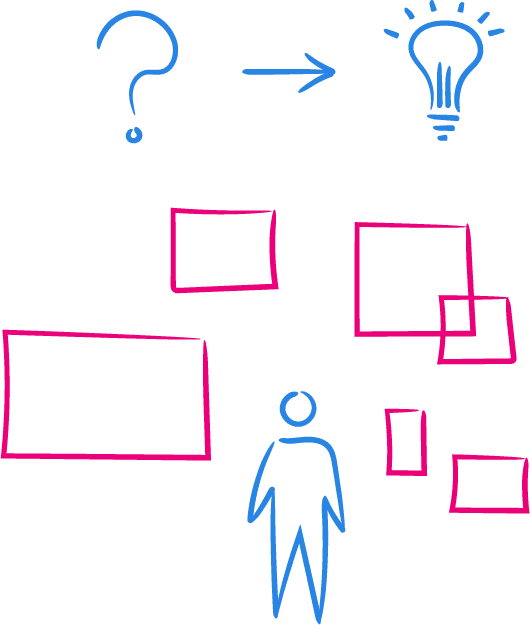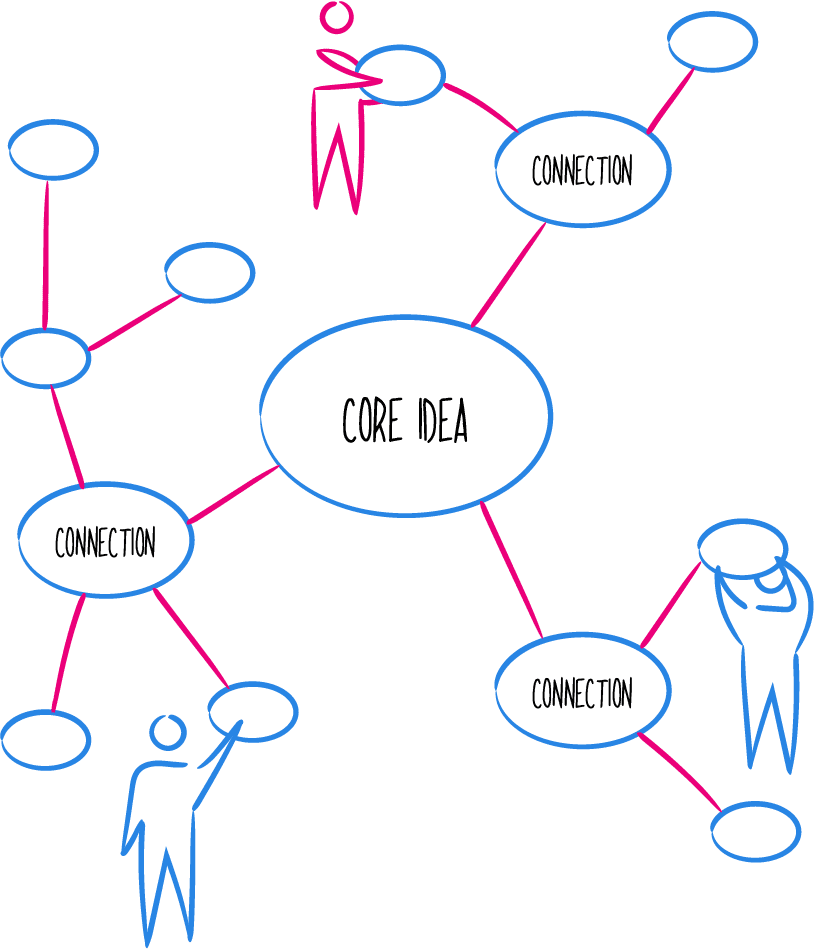Good brainstorming isn’t a shot in the dark
Four surefire ideation techniques for good brainstorming
Thursday, September 5, 2024
You’re in a meeting, and after two hours of reviewing a concept, you’re asked to brainstorm ideas. You’ve been there. We all have, and our brains are not storming anything. There’s too much pressure; it’s already been talked to death, and now we’re looking for an “Ah-ha!” moment? Good brainstorming can be a pressure cooker, but it doesn’t have to be.
These four brainstorming tactics can be used on a solo mission or in a group. At Territory, we like group brainstorming because people are like spices, and we’re not just trying to boil unseasoned chicken. People bring their own specialties, histories, and flavors to the table.
Creating (big) ideas
Brainstorming can be too taxing if you try pulling wholly formed, new ideas out of the air. Brainstorming is more akin to pushing the boundaries of your ideas. Define the space that’s available to make your meal; see how interesting you can make it without having to throw it out.
Everyone brings something different to a brainstorm, and most people have the methods that bring them success. Consequently, who you decide to brainstorm with, what type of brainstorming you use—even the location or starting concept—will impact what boundaries an innovator decides to push.
We’ve discovered these four types of brainstorming usually produce surefire results.
1. Just start writing
 A zero draft, or a skeleton draft, is simple and gets ideas flowing but can be revelatory when working individually. Making the effort to get your ideas on paper can spur different viewpoints on similar ideas and entirely new concepts. There will likely be several rounds of revisions and evolving ideas, so while a skeleton draft may start as an individual project, it’s best to involve trusted editors as part of this brainstorming idea.
A zero draft, or a skeleton draft, is simple and gets ideas flowing but can be revelatory when working individually. Making the effort to get your ideas on paper can spur different viewpoints on similar ideas and entirely new concepts. There will likely be several rounds of revisions and evolving ideas, so while a skeleton draft may start as an individual project, it’s best to involve trusted editors as part of this brainstorming idea.
Go into drafting knowing that it’s about getting ideas on paper, start fleshing them out if you can, and then put them in front of a collaborator. Depending on who your eventual audience will be, you can decide how much information to give your editor, though it’s often best to explain that you don’t need grammar or punctuation help yet.
2. Churn out concepts
 Word banking is efficient in that it takes one idea and encounters multiple variations. With many concepts floating around, it’s easy to separate the best ideas, and word banking can also clarify which concepts the team isn’t excited about or would rather stay away from.
Word banking is efficient in that it takes one idea and encounters multiple variations. With many concepts floating around, it’s easy to separate the best ideas, and word banking can also clarify which concepts the team isn’t excited about or would rather stay away from.
Part of word banking’s efficiency is simplicity. It doesn’t take a lot of energy, is easily done with multiple participants, and most of the evolution happens down the line. As a result, multiple rounds of word banking or fleshing out multiple ideas might occur. The excess of ideas is the biggest positive of word banking because innovation is often a numbers game—the more ideas, the more opportunities for success.
Word banking is best accomplished with collaborators, to keep pacing up and so focus doesn’t stall on one topic.
3. Enjoy a well-told story
 Storyboarding, or visual storytelling, is effective because many different stories can begin or end with the same information. Storyboarding can focus on a project’s ask, solution, or aftermath without starting from scratch or recreating the same information on either end. Visual storytelling is also highly scalable. It can be used to conceptualize a single problem, a workshop, a project, or an entire strategy.
Storyboarding, or visual storytelling, is effective because many different stories can begin or end with the same information. Storyboarding can focus on a project’s ask, solution, or aftermath without starting from scratch or recreating the same information on either end. Visual storytelling is also highly scalable. It can be used to conceptualize a single problem, a workshop, a project, or an entire strategy.
Because storyboarding naturally accommodates logical understanding in the form of a story, if there is a gap in logic, transition, need, or motivation, your brain will automatically notice the missed connection.
4. Define your details
 Mind mapping is often used to target details that need to be considered early on in the brainstorming process. It primarily consists of big ideas that branch out into more minor details, and it can be used to find roadblocks as projects get fleshed out. Consequently, while you’re coming up with ideas, you can know right away what details need to be solved or what ideas might be more trouble than they are worth.
Mind mapping is often used to target details that need to be considered early on in the brainstorming process. It primarily consists of big ideas that branch out into more minor details, and it can be used to find roadblocks as projects get fleshed out. Consequently, while you’re coming up with ideas, you can know right away what details need to be solved or what ideas might be more trouble than they are worth.
Mind maps are best handled in a flexible environment where many iterations can happen simultaneously. Try using a whiteboard, or a Mural board if you’re online, so you can allow as many branches as you need.
Teamwork makes the dream work
If you have a great team, like many Territory clients do, embrace them! Bringing them in as part of your process helps with buy-in and offers great and often unconsidered perspectives. Even a smaller group can contribute fresh ideas to the conversation. When brilliant minds come together to bring new ideas to life, it can feel like all eyes are on you to come up with the WOW factor. To reach your goals, assess how you brainstorm best.
Your ideas are important! Finding what best suits your needs can be the difference between a successful project and endless rounds of misaligned goals and meetings. Territory has the skills, people, and experience to help you make those judgment calls and keep your brainstorming fresh and fun.


